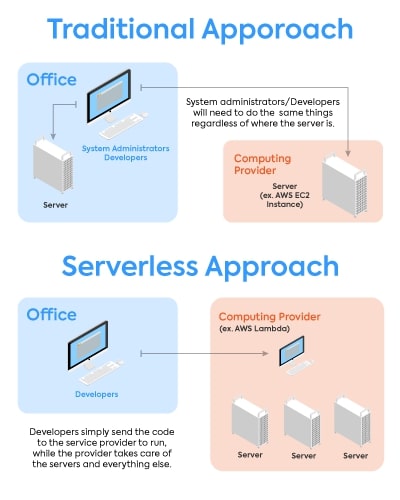Understanding Serverless Architecture vs Traditional Server-based Architecture
In the ever-evolving world of software development, choosing the right architecture is a critical decision that can significantly impact a project’s scalability, cost-effectiveness, and maintenance. Two popular architectural approaches, Serverless and traditional server-based development, have emerged as prominent choices. In this article, we’ll explore the differences between these two paradigms and analyse their respective advantages

Traditional Server-Based Development:
Traditional server-based architecture involves deploying applications on dedicated servers or virtual machines. In this model, developers are responsible for provisioning, scaling, and managing servers. Applications are typically monolithic and run continuously on the servers, which are often provisioned for peak loads.
Advantages of Traditional Server-based Architecture:
- Full control: Traditional server-based architecture gives developers full control over the infrastructure, allowing for custom configurations and optimizations.
- Predictable performance: Since applications run on dedicated servers, performance is more predictable compared to serverless architecture.
Serverless Architecture:
Serverless architecture, also known as Function as a Service (FaaS), is a cloud computing model where the cloud provider manages the infrastructure and automatically allocates resources as needed. In this model, developers write functions that are triggered by events, such as HTTP requests or database updates. These functions run in stateless containers that are managed by the cloud provider, and developers are only charged for the actual execution time of their functions.
Advantages of Serverless Architecture:
- Scalability: Serverless architecture is highly scalable, as the cloud provider automatically scales resources based on demand.
- Cost-effectiveness: With Serverless architecture, developers only pay for the resources used, making it cost-effective for applications with variable workloads.
- Simplified management: Serverless architecture simplifies infrastructure management, as developers do not need to provision or manage servers.
Serverless computing and traditional server-based architecture differ in several key aspects:
- Infrastructure Management: In serverless computing, the cloud provider manages the infrastructure, including provisioning, scaling, and maintenance of servers. Developers do not need to worry about managing servers. In contrast, in traditional server-based architecture, developers are responsible for provisioning, scaling, and maintaining servers.
- Scalability: Serverless computing is highly scalable, as the cloud provider automatically scales resources based on demand. Traditional server-based architecture requires manual scaling and provisioning of servers, which can be more complex and time-consuming.
- Cost Model: Serverless computing typically follows a pay-as-you-go model, where you only pay for the resources used. This can be cost-effective for applications with variable or unpredictable workloads. Traditional server-based architecture often involves upfront costs for provisioning servers, regardless of actual usage.
- Deployment Model: In serverless computing, applications are typically broken down into smaller functions, which are executed in response to events. This event-driven model allows for greater flexibility and scalability. In traditional server-based architecture, applications run on dedicated servers, which may limit scalability and flexibility.
- Development Experience: Serverless computing can provide a simpler development experience, as developers can focus on writing code without having to manage infrastructure. Traditional server-based architecture may require more complex setup and configuration.
- Resource Utilization: Serverless computing can be more efficient in terms of resource utilization, as resources are only allocated when functions are executed. In traditional server-based architecture, resources may be underutilized during periods of low demand.
Conclusion:
Serverless architecture and traditional server-based development have their strengths and weaknesses. The choice between them should be driven by the specific requirements of your project, your budget, and your long-term strategic goals.Ultimately, both serverless and traditional server-based approaches have their place in the software development landscape, and the best choice depends on the unique demands of your application and organization.